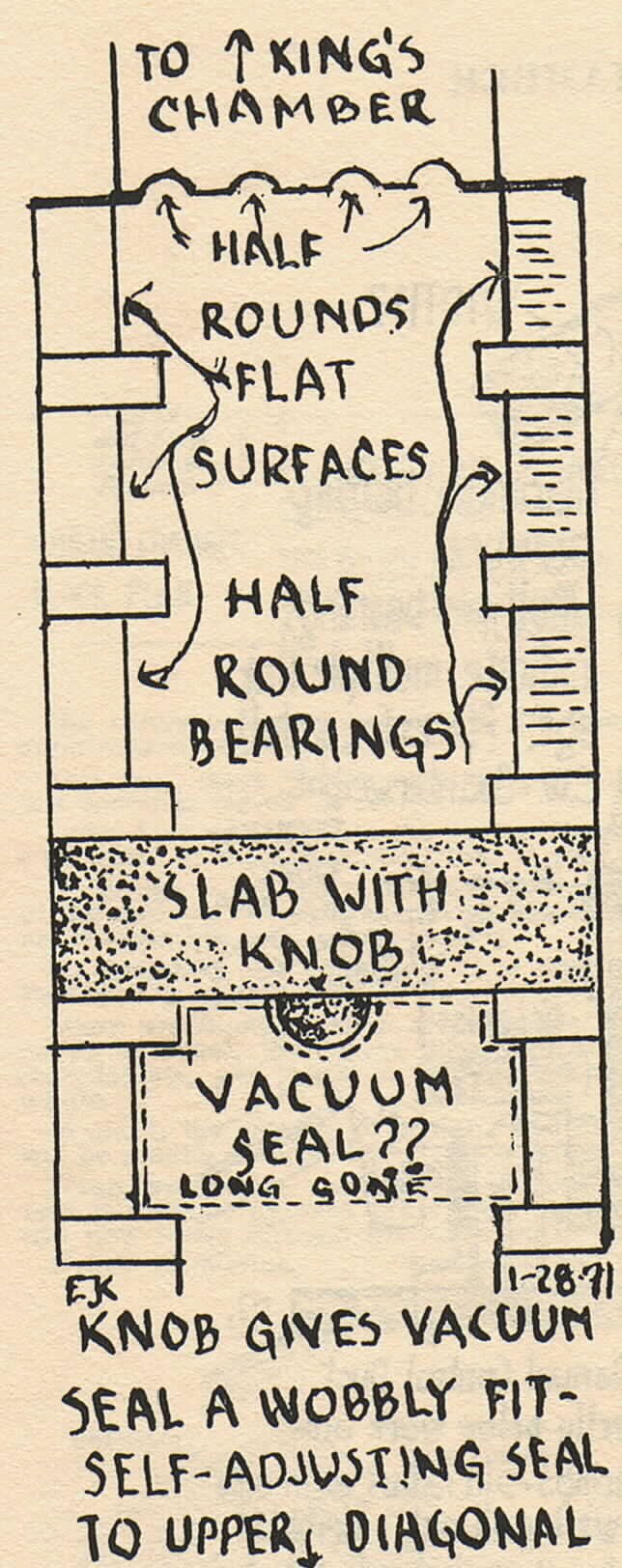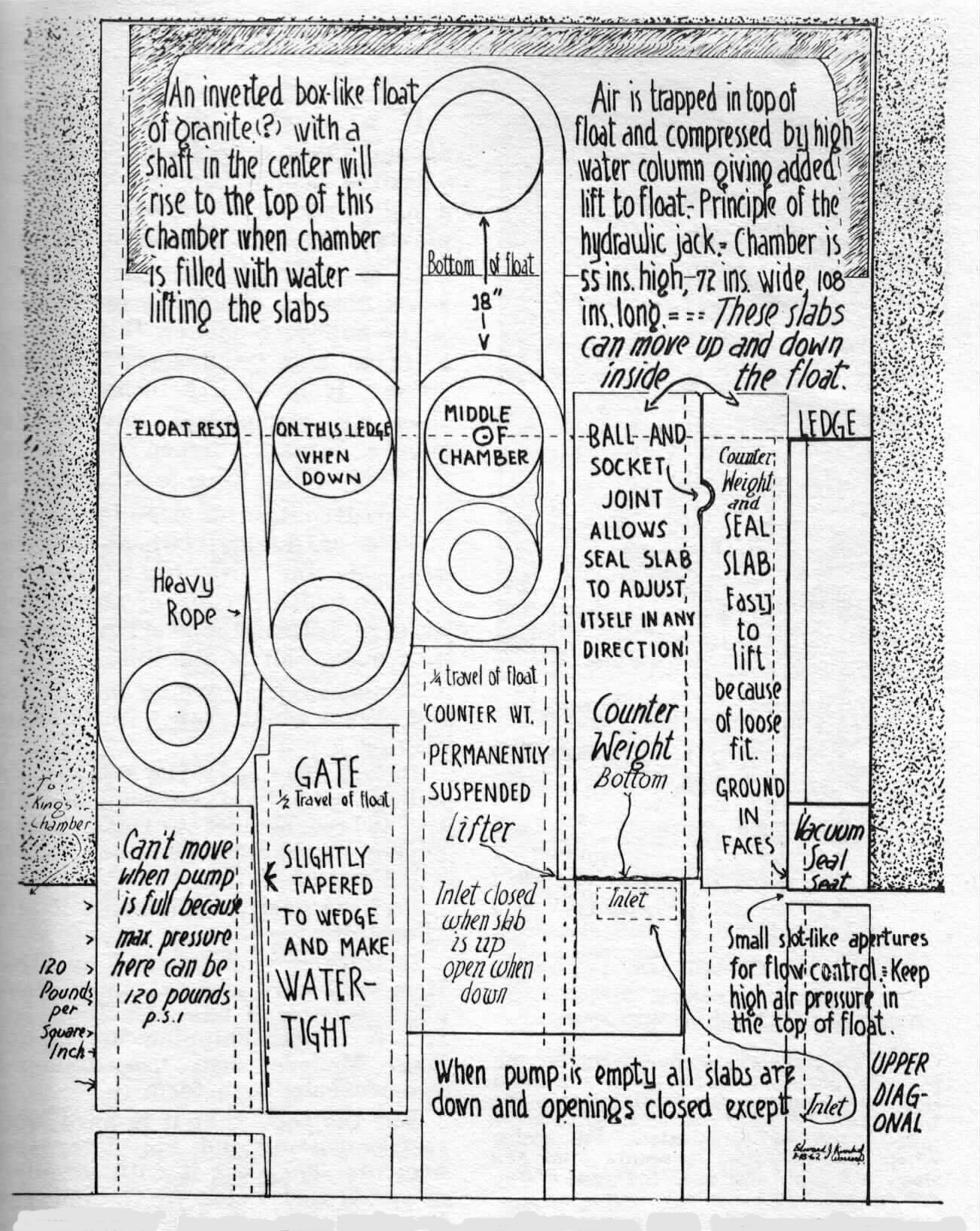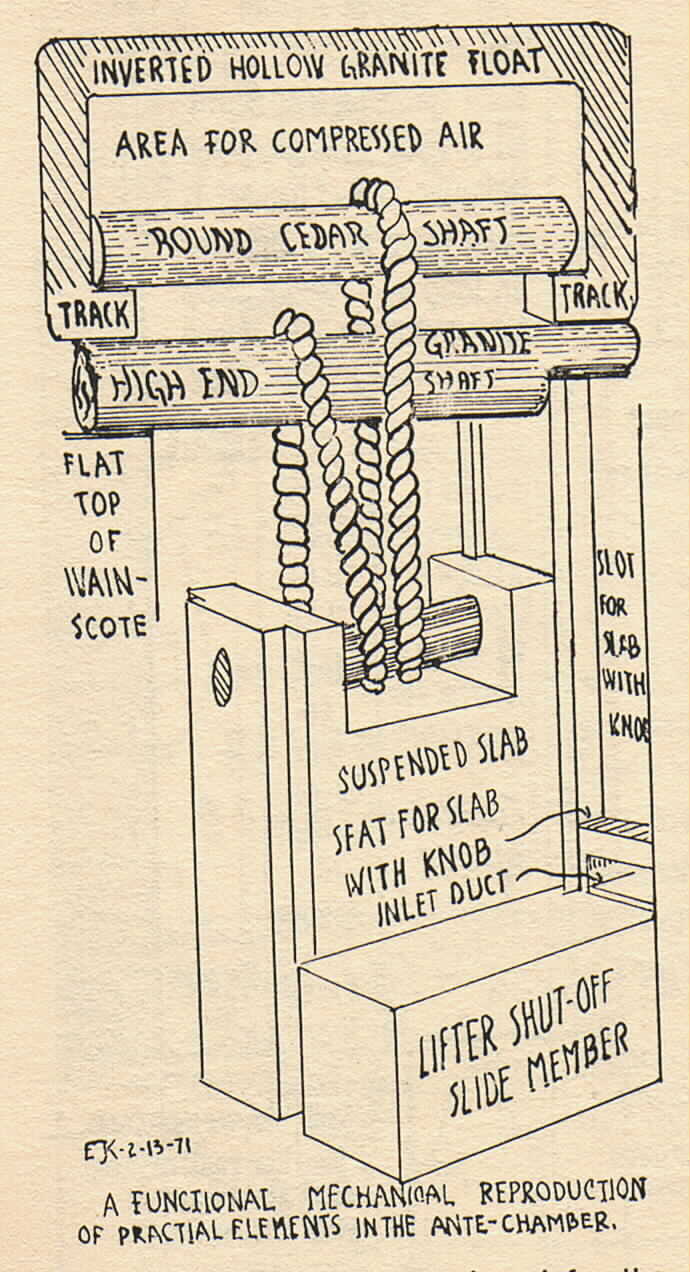Pharaoh's Pump by Edward J. Kunkel

How the Great Pyramid
At Giza was built, and Why!
 Anti-Chamber and Bowl Area
Anti-Chamber and Bowl Area 

It is the contention of the Pharaoh's Pump Foundation that the very
ineffective barriers in the passageways of the great Pyramid were really
various types of valves. The antechamber is no exception. The
Antechamber is a valve that opens when the water is highest in the Grand
Gallery and closes when the water is lowest in the Grand Gallery!
Its operation is complex and it is an integral part of the operation of
the pump. From the evidence that still survives in the form of observations
from early explorers and what still survives in the Great Pyramid Mr. Kunkel
has recreated the design of an operational valve out of available materials
that would perform its function. Below is an idea of what he talks
about in his book on how this valve operated when the pump was functional.
 A slab formed to fit the half founds shown at the top, will move
easily up and down without binding. — Plus a lubricant, makes a tight seal.
This knob was mutilated by Prof. P. Smythe in the 1860’s. He cut a piece
off the end. He called the piece, “ The Pyramid Inch.”
A slab formed to fit the half founds shown at the top, will move
easily up and down without binding. — Plus a lubricant, makes a tight seal.
This knob was mutilated by Prof. P. Smythe in the 1860’s. He cut a piece
off the end. He called the piece, “ The Pyramid Inch.”
Originally, this upper diagonal, was sealed off from the chamber
to the south of it, which is called the King’s Chamber, by a granite shut-off
mechanism, found in the part called the Anti-Chamber. Here, in this
passage, are found grooves and slots with semi-circular cuttings above
on the wainscote, which could have served as bearing for round shafts,
to which ropes were attached, to raise and lower the slabs in the grooves
or guides. To this day, a slab in its grove is found here.
It cannot close the passage, nor was it meant to be, because its grooves
do not extend to the floor. It can move up, but not all the way down.
Each side of the Anti-Chamber has a wainscote. One is found
in the east wall; the other is the west wall. The top of the wainscote
is the east wall is flat. It is 103.1 inches high; while the top
of the one in the west wall is 111.8 inches high.
In the west wall, “are three semi-cylindrical cross hollows of
9 inches radius, cut down into it.” LAGP
These are bearings. Round shafts of 18 inches diameter
can be placed in them. The round shafts will not lie in a true horizontal
position, but will be seven tenths of an inch higher on the flat top of
the wainscote.
A rotary movement of shafts so positioned will keep the shafts
snug in their bearings.
The slabs fitted tightly says Smythe, “that not even a fly could
pass in.” (LAGP) And if we add to this the use of a heavy lubricant
impervious to water, we have the makings of an airtight shut valve. — It
is my guess, that this mechanism operated by a float. And the float
may have been a hollowed out rectangular block of granite, positioned with
its open end down, like a tumbler inverted in a pan full of water.
I believe that it was made to lie at rest on the ledge on top of
the wainscote in the Ante-chamber; and that it had a round shaft in it,
positioned as shown in the drawing.
 EXPERIMENT: Invert a glass tumbler in a pail of water, Push
it down. The deeper it goes, the more it pushes upward. This
is due to compressed air trapped in the tumbler; because, the compressed
air is equal to the height of water in the pail.
EXPERIMENT: Invert a glass tumbler in a pail of water, Push
it down. The deeper it goes, the more it pushes upward. This
is due to compressed air trapped in the tumbler; because, the compressed
air is equal to the height of water in the pail.
The height of the water column in this case is approximately
125 feet, which will exert a lifting force of nearly 50 pounds per
square inch, which is a very powerful lifting force.
PROBLEM: - Invent a valve which is air-tight, and vacuum-tight, when
pump is empty. - Also, one which can be opened at will, when the pump is
full.
Also, one which can be opened at will, when the pump is full.
Authenticity, demands the use of the mechanical remnants, together
with known materials; plus known mechanical devices, invented by the Egyptian
engineers.
The known devices are; butter-fly valves, granite slabs, that
can be moved up and down in a slot, a hollowed cut rectangular box; like
the sarcophagus in the King's Chamber; plus linen rope, and round shafts.
This mechanism has one disadvantage. - It can't be closed, once
it is opened. - But it will automatically close, after the chamber is empty.
- Such a device could be used to empty the Eisenhower Lock. - A high water
column, does the business.
There are no bearings on east top of Wainscote. Edge is
seven-tenths of an inch higher than lowest point of bearing on west wall.
This design keeps round shaft snugly in place, and keeps end play friction
at a minimum.
 This drawing is whopper-jawed for the purpose of illustration. When
the float rises, the round cedar shaft rolls on the track. This rolling
movement tightens the rope which in turn raises the slabs. When Anti-Chamber
is empty float and slabs will sink and seal the Anti-Chamber.
This drawing is whopper-jawed for the purpose of illustration. When
the float rises, the round cedar shaft rolls on the track. This rolling
movement tightens the rope which in turn raises the slabs. When Anti-Chamber
is empty float and slabs will sink and seal the Anti-Chamber.
The up and down movement of the float, activates the pulley mechanism,
and causes the cedar shaft of roll back and forth on the track. This
rolling movement activates the pulley linkage.
When the float was down, the slabs were down, effectively sealing
the upper diagonal, so that a vacuum could be developed in it, while the
King’s Chamber was sealed to resist pressure.
Here in the Anti-Chamber are remains of mechanical elements which
cry loudly for the need of missing elements to make this machine complete.
The need is for a device which will raise and lower slabs at certain times
in the Ante-Chamber, and the only mechanism which can be properly fitted
to function in this odd chamber is a PULLEY. A pulley made of round
shafts together with slabs to which rollers are attached to the top.
If a heavy rope is threaded around these rollers ad shafts in
a desired fashion, the result will be a pulley mechanism about as complex
as any mad ever dreamed up.
It is believed that the ancient knew nothing about the mechanics
of the pulley, Somehow this strikes a false note, and doesn’t make sense.
It is utterly inconceivable that its mechanical advantages should remain
hidden to these masters of handling great mass.
Our definition of a pulley is, “a sheave or a small wheel with
a grooved rim with or without a block in which it runs, or any wheel used
to transmit power by means of a band, belt or the like.
Round shafts, turning in a bearing over which ropes pass, can
also be a pulley.
Before we leave the subject of pulleys and float mechanism; I’ll
try to reconstruct a float, using known mechanical elements which will
function in this Anti-Chamber.
So here goes. — I’ll make it out of granite.
Granite is rock formed by fire. It is very hard and extremely
durable. Because it has been fused by fire it resists chipping and
splitting. Modern men use diamond saws and drills to form it.
But the fact, that it is hard, and resists cutting did not deter
the ancients. They cut it with jeweled saws, drilled holes in it,
and cut thousands of inscriptions in its facing.
Contrary to popular opinion; granite is not as heavy as many
people think. It is slightly heavier than aluminum; only five pounds
per cubic foot heavier. Granite weighs 170 pounds per cubic foot.
Now, for the reconstructed float. — If you can imagine, a bath
tub cut from a block of granite, you have formed a clear basic picture
of the float.
Roughly, this tub will be 9 feet long, 6 feet wide and 3 feet
deep. It will have walls about 4 inches thick. It will be water
tight and if inverted will hold compressed air, and weight about 7,500
pounds.
If this float is cut in such a way as to form an inside lip on
each side, and the lip undercut so as to form a track for a round wooden
shaft, when the float is inverted the float is complete. (Cedar was
used extensively by the pyramid builders).
The shaft must have a sloppy fit, so that it can roll freely
back and forth on the track.
If a rope is thrown over the shaft and one end is taught; as
the float rises and sinks, the shaft will roll freely back and forth on
the track. An upward movement of the float, will make the shaft turn
in one direction; while a downward movement will make it turn in the other
direction.
I would like to elaborate somewhat on the function of the manual
control duct.
I’ll guess that it originally connected with the north discharge
tube of the King’s Chamber, because it is positioned almost at the same
level as the discharge tube.
I’ll guess too, that the part that was blasted out by Caviglia
about 1834, was the valve, (a butterfly valve) which admitted water into
the Anti-Chamber. I’ll guess too, that this small valve intrigued
him to the extent and that he believed it might be the ‘open sesame’ to
a treasure vault. — He found nothing and obliterated the valve for all
time.
When water was admitted into the Anti-Chamber through the manual
control duct, air was trapped in the inverted float, and as the float rose
it pulled the slabs up with it.
When the slabs were up, the passage was open, allowing water
from the King’s Chamber to drain into the upper diagonal.
Once this draining operation started I believe it was impossible
to stop it at will. However, as it emptied and the float came down,
it shut itself off, automatically.
Speaking of automation, observe my restoration of the slab with
the lifter. The lifter does two things. First, it lifts the
slab with knob, and then seals or shuts off the manual control duct. —
Once the King's Chamber had water in it, the slabs could always be under
water, thus, making a positive vacuum seal. The whole cycle was automatic
from start to finish. — "All the wonders of physic," says Herodotus.
During pumping operations; the Ante-Chamber is dry, and under
this circumstance, the force required to lift the slabs would be tremendous.
But, if water is admitted to the Ante-Chamber through the INLET
DUCT, all the mechanical elements in it, become submerged bodies.
Submerged bodies have a loss of weight; because they are buoyed up by water.
Granite weighs 170 pounds per cubic foot. Water weighs
62.4 pounds per cubic foot. A cubic foot of granite weighs 170 normally,
but when it is submerged it weighs 107.06 pounds. 170-62.4 = 107.6.
The INLET DUCT is connected to the discharge tube. — The
discharge tube is connected to the King's Chamber.
Thus, if water is admitted through the INLET DUCT, and
fills the Ante-Chamber, the water pressure in the King's Chamber and the
discharge tube become equal. — The columnar height of the discharge tube
determines the pressure in the Ante-Chamber.
Under this condition, there is no pressure against the slab which
seals the King's Chamber, because the pressure in both chambers are equal.
— This condition makes a very easy job for the float. — All that it must
do, is lift the submerged slabs. — Also, the float is given an upward boost
by the height of the discharge column, compressing the air trapped in the
inverted float.
At first it would seem that this complicated pulley system is
unnecessary, but one fact must be borne in mind; that during the time the
Pyramid was under construction and the King's Chamber was roofed over,
and became functional; it must be drained occasionally.
After it had been roofed over, the columnar pressure in it could
not have been more than three pounds per square inch. With such a
low working pressure; the lifting problem becomes more acute.
With such an acute problem facing the engineers, a more complex
lifting mechanism must be devised; one that will operate at extremely low
pressures, such a complicated pulley system, like the one shown here.
One mechanical fault with this arrangement, is that the upward
pull, will have a tendency to make the float wobble; therefore, close tolerances
must be adhered to in the outside dimensions of the float. The wobble
is caused by the rotation of the shaft, moving from one place to another.
In the large drawing of the Ante-Chamber you will observe that
one slab is in constant suspension.
Khalaph Al Mamoon, 835 A. D. records that when he first entered
the Pyramid, he, "heard a stone fall in a hollow place."
What could possibly fall? — A suspended slab? Of course!
A slab held up by rope for twenty-eight hundred years. The strain
of 28 centuries was just too much for the rope, — It just gave up.
Just couldn't take it any longer. Probably the slab and the rope
both heaved a sigh of relief, and were thankful that it was all over. Twenty-eight
centuries was far too long for anything to hang. — The vibration and the
fresh air did the trick.
There is so much more information about this area, both text and images
that are in the book.
Check out the FAQ page for more info about Pharaoh's Pump and the 1/2
inch to the foot, two story model that the Pharaoh's Pump Foundation is
starting to build!!!!
 Home | FAQ
Links
Please send comments or questions regarding these web pages to
Pharaoh's Pump Foundation
Copyright © 1999 Pharaoh's Pump Foundation.
Home | FAQ
Links
Please send comments or questions regarding these web pages to
Pharaoh's Pump Foundation
Copyright © 1999 Pharaoh's Pump Foundation.









